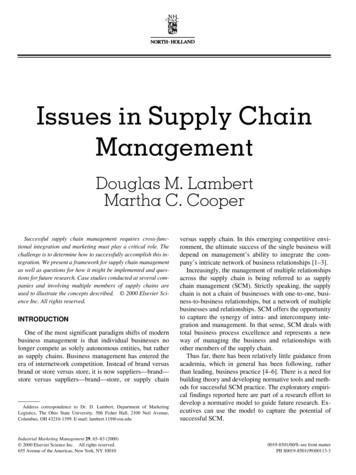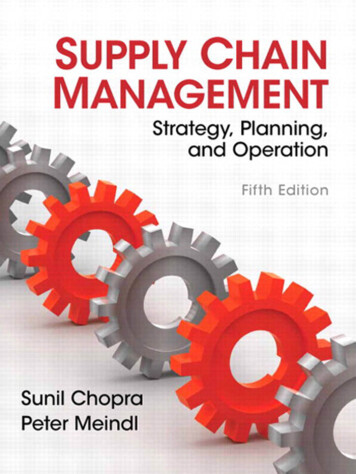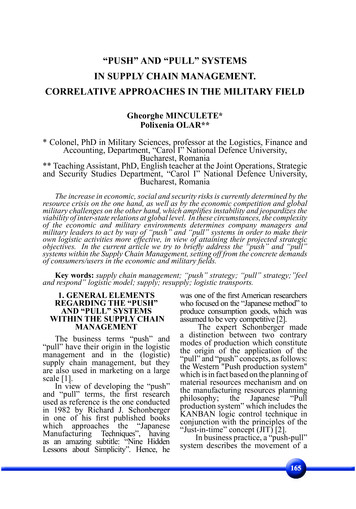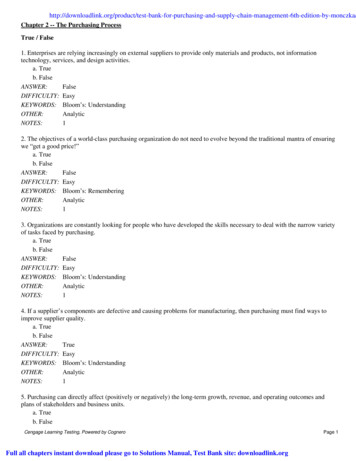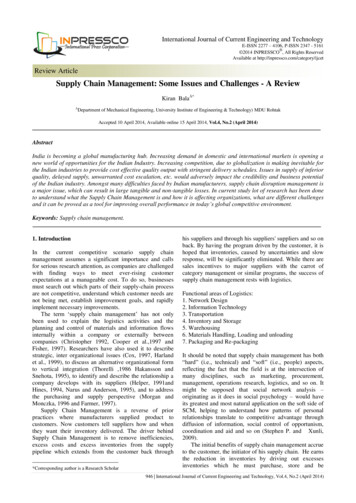
Transcription
International Journal of Current Engineering and TechnologyE-ISSN 2277 – 4106, P-ISSN 2347 - 5161 2014 INPRESSCO , All Rights ReservedAvailable at http://inpressco.com/category/ijcetReview ArticleSupply Chain Management: Some Issues and Challenges - A ReviewKiran BalaȦ*ȦDepartment of Mechanical Engineering, University Institute of Engineering & Technology) MDU RohtakAccepted 10 April 2014, Available online 15 April 2014, Vol.4, No.2 (April 2014)AbstractIndia is becoming a global manufacturing hub. Increasing demand in domestic and international markets is opening anew world of opportunities for the Indian Industry. Increasing competition, due to globalization is making inevitable forthe Indian industries to provide cost effective quality output with stringent delivery schedules. Issues in supply of inferiorquality, delayed supply, unwarranted cost escalation, etc. would adversely impact the credibility and business potentialof the Indian industry. Amongst many difficulties faced by Indian manufacturers, supply chain disruption management isa major issue, which can result in large tangible and non-tangible losses. In current study lot of research has been doneto understand what the Supply Chain Management is and how it is affecting organizations, what are different challengesand it can be proved as a tool for improving overall performance in today’s global competitive environment.Keywords: Supply chain management.1. Introduction1In the current competitive scenario supply chainmanagement assumes a significant importance and callsfor serious research attention, as companies are challengedwith finding ways to meet ever-rising customerexpectations at a manageable cost. To do so, businessesmust search out which parts of their supply-chain processare not competitive, understand which customer needs arenot being met, establish improvement goals, and rapidlyimplement necessary improvements.The term „supply chain management‟ has not onlybeen used to explain the logistics activities and theplanning and control of materials and information flowsinternally within a company or externally betweencompanies (Christopher 1992, Cooper et al.,1997 andFisher, 1997). Researchers have also used it to describestrategic, inter organizational issues (Cox, 1997, Harlandet al., 1999), to discuss an alternative organizational formto vertical integration (Thorelli ,1986 Hakansson andSnehota, 1995), to identify and describe the relationship acompany develops with its suppliers (Helper, 1991andHines, 1994, Narus and Anderson, 1995), and to addressthe purchasing and supply perspective (Morgan andMonczka, 1996 and Farmer, 1997).Supply Chain Management is a reverse of priorpractices where manufacturers supplied product tocustomers. Now customers tell suppliers how and whenthey want their inventory delivered. The driver behindSupply Chain Management is to remove inefficiencies,excess costs and excess inventories from the supplypipeline which extends from the customer back through*Corresponding author is a Research Scholarhis suppliers and through his suppliers' suppliers and so onback. By having the program driven by the customer, it ishoped that inventories, caused by uncertainties and slowresponse, will be significantly eliminated. While there aresales incentives to major suppliers with the carrot ofcategory management or similar programs, the success ofsupply chain management rests with logistics.Functional areas of Logistics:1. Network Design2. Information Technology3. Transportation4. Inventory and Storage5. Warehousing6. Materials Handling, Loading and unloading7. Packaging and Re-packagingIt should be noted that supply chain management has both“hard” (i.e., technical) and “soft” (i.e., people) aspects,reflecting the fact that the field is at the intersection ofmany disciplines, such as marketing, procurement,management, operations research, logistics, and so on. Itmight be supposed that social network analysis –originating as it does in social psychology – would haveits greatest and most natural application on the soft side ofSCM, helping to understand how patterns of personalrelationships translate to competitive advantage throughdiffusion of information, social control of opportunism,coordination and aid and so on (Stephen P. and Xunli,2009).The initial benefits of supply chain management accrueto the customer, the initiator of his supply chain. He earnsthe reduction in inventories by driving out excessesinventories which he must purchase, store and be946 International Journal of Current Engineering and Technology, Vol.4, No.2 (April 2014)
Kiran BalaSupply Chain Management: Some Issues and Challenges - A Reviewresponsible for. The impact of supply chain managementto the supplier may be more difficult to classify, initially,as benefits. They may vary, but may include: Fewer orders initially while the customer draws downexcess inventories. Small and more frequent orders. Vendor carries inventory, not the customer. Higher warehousing costs for picking smaller andmore orders. Higher freight costs for shipping smaller order andmore orders. Penalties for not meeting the customer's requirements. Possible loss of business for not meeting thecustomer's requirements.Suppliers play a crucial role because they help Indianfirms to improve supply chain cost, responsiveness,reliability and its competitiveness. Therefore managementof sourcing in terms of Supply Risks (i.e., delays in receiptof the material; or mismatch in quantity supplied; ormaterial being of inferior quality or damaged; or thealteration in commercial terms delaying the supply) is verycrucial. A solution to this problem is to manage supplydelays by managing the supply risks. Supply Risk isdefined as, “The potential occurrence of an incidentassociated with inbound supply from individual supplierfailures or the supply market, in which its outcome resultsin the inability of the purchasing firm to meet customerdemand or cause threats to customer life and safety”. Thismeans non availability of the required material at therequired time in spite of the order being placed for inputmaterials on time and delivery date / quantity / cost areagreed with the supplier well in advance as per the agreednorms.If a company has one hundred customers, he may haveone hundred customer practices. This is the mostchallenging job for SCM to keep all the customerssatisfied rather delighted. Emphasis is presently on theinitial customer-supplier link. (Ketkar and Vaidya, 2012)The effects ripple through the supply chain, it is more likea "whisper down the lane" impact, where suppliers are notclear as to their role and what they must do. Customerswant more quality, design, innovation, choice,convenience and service, and they want to spend lessmoney, effort, time and risk. The supply chain of acompany consists of different departments, ranging fromprocurement of materials to customer service.Supply Chain Management means transforming acompany‟s “supply chain” into an optimally efficient,customer-satisfying process, where the effectiveness of thewhole supply chain is more important than effectivenessof each individual department.Previously manufacturers were the drivers of thesupply chain - managing the pace at which products weremanufactured and distributed. Today, customers arecalling the shots, and manufacturers are scrambling tomeet customer demands for options/styles/ features, quickorder fulfillment, and fast delivery. Manufacturing quality– a long-time competitive differentiator - is approachingparity across the board, so meeting customer‟s specificdemands for product delivery has emerged as the nextcritical opportunity for competitive advantage. Companiesthat learn how to improve management of their supplychain will become the new success stories in the globalmarket place. Study on Benchmarking shows significantcost differences between organizations that exhibit best-inclass performance and those with average performance.Traditionally, Supply Chain Management (SCM) has beena melting pot of various aspects, with influences fromlogistics and transportation, operations management andmaterials and distribution management, marketing, as wellas purchasing and information technology (IT). Ideally,the allen compassing philosophy of SCM embraces eachof these functions to produce an overall supply chainstrategy that ultimately enhances firm performance(Croom et al., 2000 and Wisner and Tan, 2000). Inactuality, the literature is still very fragmented andalthough several studies purport to discuss supply chainissues, most of the existing research only examines onelink of the chain, or most importantly only focuses on oneingredient in the supply chain performance mix. Six majormovements can be observed in the evolution of supplychain management studies. Creation, Integration,Globalization, Specialization Phases One and Two, andSCM 2.0 These phases are given in Table 1. The six stageevolutionary era depicts that in a particular era whichstrategy was emphasized. For instance in the sixth erainformation Technology was given priority and IT enabledsupply chain was the burning issue.2. Literature ReviewAnalytically, a typical supply chain (Figure 1) is simply anetwork of materials, information and services processinglinks with the characteristics of supply, transformation anddemand. It is the collection and interaction of theseelements that impact system-level qualities, properties,characteristics , functions, behavior, and performance (Cloutier et al., 2010).Enterprises create and deliver products and servicesthrough increasingly global and complex supply chains (Binder and Clegg ,2007 and Basole and Rouse, 2008).The hyper competitive nature of today‟s ontinuously seek ways to decrease operational costs,provide satisfactory customer service, and minimizeexisting and anticipated disruption risks by designing andmanaging efficient supply chains.Figure 2.1: Company‟s Supply Chain(John Storey, Caroline Emberson, Janet Godsell and AlanHarrison, 2006) in their paper “Supply chain management:theory, practice and future challenges” critically assesscurrentdevelopmentsinthetheory947 International Journal of Current Engineering and Technology, Vol.4, No.2 (April 2014)
Kiran BalaSupply Chain Management: Some Issues and Challenges - A ReviewTable-1 Era in the Evolution of Supply Chain ManagementS.No.EraDescription01Creation Era02Integration EraThe term supply chain management was first coined by an American industry consultantin the early 1980s. However the concept of supply chain in management, was of greatimportance long before in the early 20th century, especially by the creation of theassembly line.This era of supply chain management studies was highlighted with the development ofElectronic Data Interchange (EDI) systems in the 1960s and developed through the 1990sby the introduction of Enterprise Resource Planning (ERP) systems.03Globalization Era04Specialization(Phase one)05Specialization Era(Phase two)06Supply Chain(SCM 2. 0)This era is characterized by the globalization of supply chain management inorganizations with the goal of increasing competitive advantage, creating more valueadded, and reducing costs through global sourcingIn the 1990s industries began to focus on “core competencies” and adopted aspecialization model. Companies abandoned vertical integration, sold off non-coreoperations, and outsourced those functions to other companies.Specialization within the supply chain began in the 1980s with the Phase Two – Supplyinception of transportation brokerages, warehouse management, and non asset basedcarriers and has matured beyond transportation and logistics into aspects of supplyplanning, collaboration, execution and performanceWeb 2. 0 is defined as a trend in the use of the World Wide Web that is meant to increasecreativity, information sharing, and collaboration among users.and practice of supply management and through such anassessment to identify barriers, possibilities and keytrends. The paper reveals that supply management is, atbest, still emergent in terms of both theory and practice.The paper identifies the range of key barriers and enablersto supply management and it concludes with anassessment of the main trends.(Omera Khan and Bernard Burnes, 2007) in their study“Risk and supply chain management: creating a researchagenda” develop a research agenda for risk and supplychain management. The paper shows that there are anumber of key debates in the general literature on risk,especially in terms of qualitative versus quantitativeapproaches, which need to be recognized by those seekingto apply risk theory and risk management approaches tosupply chains. In addition, the paper shows that theapplication of risk theory to supply chain management isstill in its early stages and that the models of supply chainrisk which have been proposed need to be testedempirically.(Mary J. Meixell and Vidyaranya B. Gargeya, 2005) intheir paper “Global supply chain design: A literaturereview and critique” they review decision support modelsfor the design of global supply chains, and assess the fitbetween the research literature in this area and thepractical issues of global supply chain design. Theclassification scheme for this review is based on ongoingand emerging issues in global supply chain managementand includes review dimensions for (1) decisionsaddressed in the model, (2) performance metrics, (3) thedegree to which the model supports integrated decisionprocesses, and (4) globalization considerations. A supplychain design problem comprises the decisions regardingthe number and location of production facilities, theamount of capacity at each facility, the assignment of eachmarket region to one or more locations, and supplierselection for sub-assemblies, components and materials(Chopra and Meindl, 2004). Experts maintain that globalsupply chains are more difficult to manage than d
supply chain management rests with logistics. Functional areas of Logistics: 1. Network Design 2. Information Technology 3. Transportation 4. Inventory and

